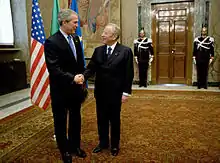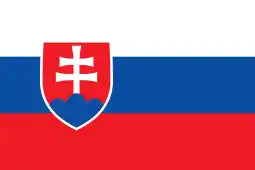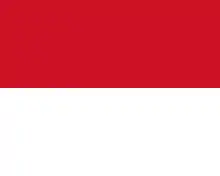Carlo Azeglio Ciampi
Carlo Azeglio Ciampi (Italian pronunciation: [ˈkarlo adˈdzeʎʎo ˈtʃampi] (![]() listen); 9 December 1920[2] – 16 September 2016[3]) was an Italian politician and banker. He was the 49th Prime Minister of Italy from 1993 to 1994 and was the tenth President of Italy from 1999 to 2006.
listen); 9 December 1920[2] – 16 September 2016[3]) was an Italian politician and banker. He was the 49th Prime Minister of Italy from 1993 to 1994 and was the tenth President of Italy from 1999 to 2006.
Carlo Azeglio Ciampi | |
|---|---|
 | |
| President of Italy | |
| In office 18 May 1999 – 15 May 2006 | |
| Prime Minister | Massimo D'Alema Giuliano Amato Silvio Berlusconi |
| Preceded by | Oscar Luigi Scalfaro |
| Succeeded by | Giorgio Napolitano |
| Prime Minister of Italy | |
| In office 28 April 1993 – 10 May 1994 | |
| President | Oscar Luigi Scalfaro |
| Preceded by | Giuliano Amato |
| Succeeded by | Silvio Berlusconi |
| Minister of the Treasury, Budget and Economic Programming | |
| In office 17 July 1996 – 13 May 1999 | |
| Prime Minister | Romano Prodi Massimo D'Alema |
| Preceded by | Lamberto Dini (Treasury) Mario Arcelli (Budget) |
| Succeeded by | Giuliano Amato |
| Minister of the Interior | |
| In office 19 April 1994 – 10 May 1994 | |
| Government | Ciampi |
| Preceded by | Nicola Mancino |
| Succeeded by | Roberto Maroni |
| Minister of Tourism and Entertainment | |
| In office 28 April 1993 – 10 May 1994 | |
| Government | Ciampi |
| Preceded by | Margherita Boniver |
| Succeeded by | Domenico Fisichella |
| Governor of the Bank of Italy | |
| In office 8 October 1979 – 29 April 1993 | |
| Preceded by | Paolo Baffi |
| Succeeded by | Antonio Fazio |
| Director General of the Bank of Italy | |
| In office 28 June 1978 – 8 October 1979 | |
| Preceded by | Mario Ercolani |
| Succeeded by | Lamberto Dini |
| Member of the Senate | |
| In office 15 May 2006 – 16 September 2016 | |
| Personal details | |
| Born | 9 December 1920 Livorno, Tuscany, Kingdom of Italy |
| Died | 16 September 2016 (aged 95) Rome, Latium, Italy |
| Nationality | Italian |
| Political party | PdA (1943–1947) Independent (1947–2016)[1] |
| Height | 1.63 m (5 ft 4 in) |
| Spouse(s) | Franca Pilla (m. 1946–2016, his death) |
| Children | 2 |
| Alma mater | Scuola Normale of Pisa |
| Profession | Economist, politician |
| Signature | |
Biography
Education
Ciampi was born in Livorno (Province of Livorno).[4]
He received a B.A. in ancient Greek literature and classical philology in 1941 from the Scuola Normale Superiore di Pisa, one of the country's most prestigious universities, defending a thesis entitled Favorino d'Arelate e la consolazione Περὶ φυγῆς[5] under the direction of the Hellenist Augusto Mancini. Then he was called to military duty in Albania as a lieutenant. On 8 September 1943, on the date of the armistice with the Allies, he refused to remain in the Fascist Italian Social Republic, and took refuge in Abruzzo, in Scanno. He subsequently managed to pass the lines and reach Bari, where he joined the Partito d'Azione (and thus the Italian resistance movement).
In 1946 he married Franca Pilla. That same year, he obtained a B.A. in law from the University of Pisa and began working at the Banca d'Italia. He also joined the CGIL (Trade Union), which he left in 1980.
Bank of Italy
In 1960, he was called to work in the central administration of the Bank of Italy, where he became Secretary General in 1973, Vice Director General in 1976, and Director General in 1978. In October 1979, he was nominated Governor of the Bank of Italy and President of the national Bureau de Change, positions he filled until 1993.
Political career
Ciampi was the first non-parliamentarian prime minister of Italy in more than 100 years.[6] From April 1993 to May 1994 he oversaw a technical government. Later, as treasury minister from 1996 to May 1999 in the governments of Romano Prodi and Massimo D'Alema, he was credited with adopting the euro currency. He personally chose the Italian design for the 1-euro coin, whereas all others were left to a television vote among some candidates the ministry had prepared (see also: Italian euro coins).
Ciampi chose the Vitruvian man of Leonardo da Vinci, on the symbolic grounds that it represented man as a measure of all things, and in particular of the coin: in this perspective, money was at the service of man, instead of its opposite. The design also fitted very well on the bimetallic material of the coin.
According to the Italian weekly Famiglia Cristiana, in 1993 Ciampi was a member of the regular Masonic Lodge "Hermes" of Livorno which was affiliated to the Grand Orient of Italy and linked the socalled Rito Filosofico Italiano.[7]
President (1999–2006)

Ciampi was elected with a broad majority, and was the second president ever to be elected at the first ballot (when there is a requirement of a two-thirds majority) in a joint session of the Chamber of Deputies, the Italian Senate and representatives of the Regions.
He usually refrained from intervening directly into the political debate while serving as President. However, he often addressed general issues, without mentioning their connection to the current political debate, in order to state his opinion without being too intrusive. His interventions have frequently stressed the need for all parties to respect the constitution and observe the proprieties of political debate. He was generally held in high regard by all political forces represented in the parliament. The possibility of persuading Ciampi to stand for a second term as President by the election 2006 – the so-called Ciampi-bis – was widely discussed, despite his advancing age, but it was officially dismissed by Ciampi himself on 3 May 2006: "None of the past nine presidents of the Republic has been re-elected. I think this has become a meaningful rule. It is better not to infringe it". Ciampi, whose mandate was due to expired on the 18th, resigned on the 15th. His successor, Giorgio Napolitano took the oath on the same day.
As head of state of the host country, he officially declared the 2006 Winter Olympics open, on the 10th of February 2006.
As President, Ciampi was not considered to be close to the positions of the Vatican and the Catholic Church, in a sort of alternance after the devout Oscar Luigi Scalfaro. He often praised patriotism, not always a common feeling in Italy because of its abuse by the fascist regime.
== Death (2016) ==
He died in Rome on 16 September 2016 at the age of 95.[8][9][10]
Awards and honours
As President of the Italian Republic between 18 May 1999 and 15 May 2006, Ciampi held the roles of:
- Head of the Order of Merit of the Italian Republic
- Chief of the Military Order of Italy
- Head of the Order of Merit for Labour
- Head of the Order of the Star of Italian Solidarity
- Head of the Order of Vittorio Veneto
- Bailiff Grand Cross of Honour and Devotion of the Sovereign Military Order of Malta
- Collar of the Order of Pius IX (Papal Order)
- 1982: Great Cross of the Order of Merit of the Italian Republic
- 1985: Commander of the Legion of Honour (France)
- 1986: Great Cross of Merit of the Federal Republic of Germany
- 1991: Honorary degree, University of Pavia
- 1993: Grand Cordon of the Order of the Rising Sun (Japan)
- 1995: Freeman of the City of Naples
- 1999: Collar of the Order of the White Rose (Finland)
- 2000: Gold Medal of the Jean Monnet Foundation for Europe
- 2000: Knight Grand Cross of the Order of the Bath (United Kingdom, 16 October 2000)
- 2000:
 Knight Grand Cross of the Order of the White Eagle (Poland)
Knight Grand Cross of the Order of the White Eagle (Poland) - 2001: Knight Grand Cross of the Royal Norwegian Order of St. Olav
- 2001: Medal of the Oriental Republic of Uruguay.[11]
- 2001: Grand Cross of the Grand Order of King Tomislav ("For outstanding contribution to the promotion of friendship and development co-operation between the Republic of Croatia and the Italian Republic." – Croatia, 19 October 2001)
- 2001: Honorary doctorate from the University of Leipzig Faculty of Economics
- 2002: Grand Star of Honour for Services to the Republic of Austria
- 2002:
 – Grand Cross (or 1st Class) of the Order of the White Double Cross (Slovakia)[12]
– Grand Cross (or 1st Class) of the Order of the White Double Cross (Slovakia)[12] - 2002: Grand Collar of the Order of Prince Henry (Portugal, 22 February 2002)
- 2002: Grand Cross with Collar of the Order of Merit of the Hungarian Republic
- 2002: Collar Pro Merito Melitensi of the Sovereign Military Order of Malta
- 2003: Collar of the Order of the Star of Romania
- 2003:
 – Honorary Recipient of the Order of the Crown of the Realm (Malaysia)[13]
– Honorary Recipient of the Order of the Crown of the Realm (Malaysia)[13] - 2004: Collar of the Order of the Cross of Terra Mariana (Estonia)
- 2004: Commander Grand Cross with Chain of the Order of Three Stars (Latvia)
- (Malta, 19 May 2005) Honorary Member of the Xirka Ġieħ ir-Repubblika
- 2005: Charlemagne Prize
- 2005:
 – Grand Cross of the Order of Saint-Charles (Monaco, 13 December 2005)[14]
– Grand Cross of the Order of Saint-Charles (Monaco, 13 December 2005)[14] - March 2005: honorary Doctor of Civil Law degree form the Oxford University
- Grand Cross of the Order of the Southern Cross (Brazil)
- 2008: Honorary doctorate from the Economics Faculty of the University of Augsburg
- 15 June 2005: honorary doctorate by the École Normale Supérieure of Paris.
References
- Breda, Marzio (15 July 2009). "Pd avvilente ma eviti scissioni. Sì a Bersani, vero rifondatore". Corriere della Sera (in Italian).
La mia ultima tessera […] è stata quella del Partito d'azione, e altre non ne ho mai più volute.
- East, Roger; Thomas, Richard J. (3 June 2014). Profiles of People in Power: The World's Government Leaders. Routledge. ISBN 9781317639404. Retrieved 6 April 2018 – via Google Books.
- "Carlo Azeglio Ciampi (1920–2016)".
- Page at Senate website (in Italian).
- Favorinus of Arles and the Consolation Περὶ φυγῆς, anastatic reprint by the Scuola Normale di Pisa editions, editor Franco Montanari, introduction of Salvatore Settis, ISBN 978-88-7642-411-3.
- Wentworth, Richard L. (28 April 1993). "Italy Turns to a Banker to Form Government". The Christian Science Monitor. Retrieved 26 April 2013.
- Alberto Spampinato, La lezione di Ciampi, Soverio Mannelli, Rubbettino editore, 2006, pp. 76-77. OCLC 238799437.
- Italy's former President Carlo Azeglio Ciampi dies aged 95 Wall Street Journal
- Former Italian President Carlo Azeglio Ciampi dies at 95 The Guardian
- "Carlo Azeglio Ciampi, Former Italian Prime Minister, Dies at 95". The New York Times. 16 September 2016. Retrieved 18 September 2016.
- "Resolución N° 374/001". www.impo.com.uy. Retrieved 28 November 2020.
- Slovak republic website, State honours Archived 13 April 2016 at the Wayback Machine : 1st Class in 2002 (click on "Holders of the Order of the 1st Class White Double Cross" to see the holders' table)
- "Semakan Penerima Darjah Kebesaran, Bintang, dan Pingat Persekutuan".
- Nomination by Sovereign Ordonnance n° 331 13 December 2005 (French)
.svg.png.webp)


